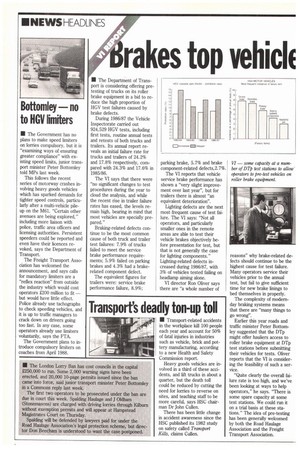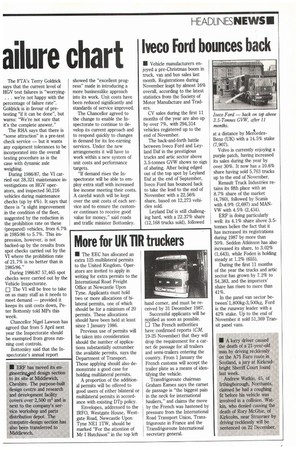rakes top vehick ailure chart
Page 6

Page 7

If you've noticed an error in this article please click here to report it so we can fix it.
• The Department of Transport is considering offering pretesting of trucks on its roller brake equipment in a bid to reduce the high proportion of HGV test failures caused by brake defects.
During 1986/87 the Vehicle Inspectorate carried out 924,529 HGV tests, including first tests, routine annual tests and retests of both trucks and trailers. Its annual report reveals an initial failure rate for trucks and trailers of 24.2% and 17.8% respectively, compared with 24.3% and 17.6% in 1985/86.
The VI says that there were "no significant changes to test procedures during the year to cloud the analysis, and while the recent rise in trailer failure rates has eased, the levels remain high, bearing in mind that most vehicles are specially prepared."
Braking-related defects continue to be the most common cause of both truck and trailer test failures: 7.9% of trucks failed to meet the service brake performance requirements; 5.9% failed on parking brakes and 4.3% had a brakerelated component defect.
The equivalent figures for trailers were: service brake performance failure, 8.9%; parking brake, 5.7% and brake component-related defects,2.7%.
The VI reports that vehicle service brake performance has shown a "very slight improvement over last year", but for trailers there is almost "an equivalent deterioration".
Lighting defects are the next most frequent cause of test failure. The VI says: "Not all operators, and particularly smaller ones in the remote areas are able to test their vehicle brakes objectively before presentation for test, but that is not generally the case for lighting components." Lighting-related defects increased during 1986/87, with 3% of vehicles tested failing on headlamp aiming alone.
VI director Ron Oliver says there are "a whole number of reasons" why brake-related defects should continue to be the highest cause for test failure. Many operators service their vehicles prior to the annual test, but fail to give sufficient time for new brake linings to bed themselves in properly.
The complexity of modernday braking systems means that there are "many things to go wrong".
Earlier this year roads and traffic minister Peter Bottomley suggested that the Dip might offer hauliers access to roller brake equipment at DTp test stations before submitting their vehicles for tests. Oliver reports that the VI is considering the feasibility of such a service.
"Quite clearly the overall failure rate is too high, and we've been looking at ways to help operators," he says. "There is some spare capacity at some test stations. We could run it on a trial basis at these stations." The idea of pre-testing has been generally welcomed by both the Road Haulage Association and the Freight Transport Association. The FTA's Terry Goldrick says that the current level of HGV test failures is "worrying. . . we're not happy with the percentage of failure rate". Goldrick is in favour of pretesting "if it can be done", but warns: "We're not sure that it's the complete answer."
The RHA says that there is "some attraction" in a pre-test check service — but it wants any equipment tolerances to be incorporated into the overall testing procedure as is the case with dynamic axle weighing.
During 1986/87, the VI carried out 28,321 maintenance investigations on HGV operators, and inspected 50,216 vehicles during maintenance checks (up by 4%). It says that there is "a slight improvement in the condition of the fleet, suggested by the reduction in the prohibition rate on these (prepared) vehicles, from 6.7% in 1985/86 to 5.7%. This impression, however, is not backed-up by the results from spot checks carried out by the VI where the prohibition rate of 21.7% is no better than in 1985/86."
During 1986/87 57,465 spot checks were carried out by the Vehicle Inspectorate.
p The VI will be free to take on as many staff as it needs to meet demand — provided it keeps its unit costs down, Peter Boftomly told MPs this week.
Chancellor Nigel Lawson has agreed that from 5 April next year the Inspectorate should be exempted from gross running cost controls.
Bottornley said that the Inspectorate's annual report showed the "excellent progress" made in introducing a more businesslike approach into its work. Unit costs have been reduced significantly and standards of service improved.
The Chancellor agreed to the change to enable the Inspectorate to continue to develop its current approach and to respond quickly to changes in demand for its fee-earning services. Under the new arrangements it will have to work within a new system of unit costs and performance targets.
"If demand rises the Inspectorate will be able to employ extra staff with increased fee income meeting their costs. A careful watch will be kept over the unit costs of each service and to ensure the customer continues to receive good value for money," said roads and traffic minister Bottoinley.
































































































